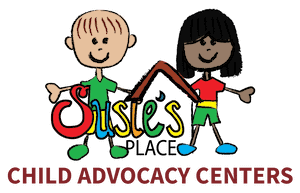A series of rapid events unfold when anyone reports suspected child abuse. First, either law enforcement or the Indiana Department of Child Services (DCS), will:
- Investigate the information and try to discern whether or not a child might have been the victim of—or witness to—a crime.
- Quickly make contact with the child to visibly confirm they are safe.
- Ask the child a few initial questions about what they saw, heard, or experienced.
Once law enforcement or DCS caseworkers in our service area find evidence that a child has likely been abused, sexually assaulted, witnessed a crime, or otherwise suffered maltreatment, they bring them and their non-offending caregivers to Susie’s Place.
Forensic interviews are free and designed to be child-first and non-leading
Forensic interviewing is a skill acquired through intense training and research. The ability to help a child feel safe and talk about what they saw and experienced is challenging, but critical to their recovery.
- Forensic interviews are provided at no-cost to families.
- The techniques used to conduct forensic interviews are honed from years of research and best practices worldwide.
- Forensic interviewers at Susie’s Place are highly trained and experienced in these special conversations.
- Interviews are designed to reduce the recurrence of trauma and the number of times a child has to retell their experience (e.g., once to the police, later to DCS, then more investigators, then prosecutors, then in court, etc.)
- Throughout the whole forensic interview, the interviewer is calm, objective, and only asks clarifying questions without praising a child for giving answers that imply innocence or guilt on others.
Here’s what happens during the forensic interview
Every forensic interview at Susie’s Place involves only one interviewer in a room with a child.
The child never sees the multidisciplinary team (MDT) of detectives, officers, investigators, caseworkers, and prosecutors.
The MDT is watching the interview from a separate closed-circuit camera discreetly placed in the interview room.
The team can talk one-way with an interviewer through an earpiece.
Investigators and prosecutors in a separate room can talk to the interviewer through an earpiece. Investigators might say, “Ask them about the clothes they were wearing.” The interviewer then might ask the child, “You said someone was wearing a hat. Tell me everything you remember about the hat.”

The forensic interview process works in five broad steps:
- The interviewer builds rapport with children in a safe, neutral way. Interviewers will never call a child “buddy” or “pal”, but instead work to build trust by speaking to them at their developmental level. This way, a child not only feels safe but knows they are safe.
- The interviewer asks questions to help understand what the child understands, like the difference between truth and something untruthful. This is important because every forensic interview is recorded, and many are played later in court.
- The child is asked to identify people in their family, the relationships between them and the alleged perpetrator, where they were, and conversations about body safety and how to keep their bodies safe. These questions are non-leading and designed to be age-appropriate.
- The child is given the opportunity to affirm or deny an allegation. This process can take a few minutes or many hours, but the interviewer is listening for a child to discuss what may or may not have happened and is asking non-leading questions to gather details.
- At the end, the child can ask questions and is reminded they have safe adults to talk to. The interviewer then gives the report, the recording of the interview, and any notes a child may have drawn or written to the investigators, caseworkers, and prosecutors.
Forensic interviewers are trained to ask non-leading questions like, “Tell me everything that happened after school yesterday” and not “Were you at school when he touched you?”

A high-quality interview can help prosecution
High-quality forensic interview techniques are designed to serve as evidence that holds up in court. While not every forensic interview is admitted to court as evidence, we work to ensure those that are played for a jury or judge hold up to cross-examination and support justice.
For instance, if a child is the only witness to a crime, their testimony and initial interview at Susie’s Place are critical pieces of evidence. Susie’s Place interviewers are highly trained to balance the needs of the child with the needs of the investigation.
The interview is the first step to healing
Susie’s Place provides help to children and non-offending caregivers or parents during and after the interview. Child and Family Advocates are on-site to answer questions and connect people with mental health referrals, specialized medical health exams, understand the judicial process, and more.




